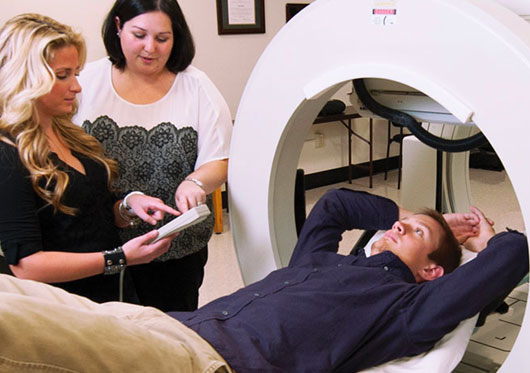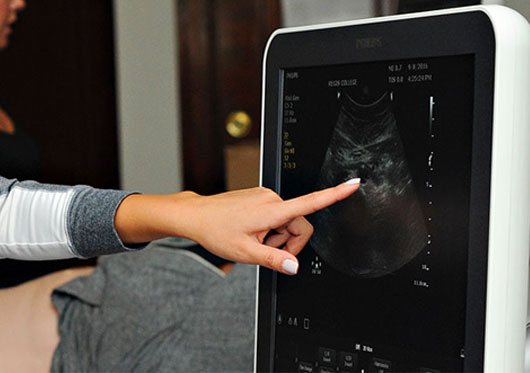Healthcare is a thriving industry that offers a plethora of job opportunities to young professionals, such as medical imaging. Unlike other healthcare professions, individuals pursuing a career in medical imaging can enter the field and make a difference quickly without spending multiple years in medical school.
What is Medical Imaging?
Medical imaging is a vital part of modern day medicine. It refers to the technologies used to examine various parts of the human body to diagnose, monitor, and generate future treatment plans. Some of these non-invasive technologies include:
- Computed tomography
- Magnetic resonance imaging
- Sonography
There are several different types of medical imaging, each offering important information for treatment. For anyone experiencing an injury, suffering from chronic pain, or facing another medical condition, medical imaging helps doctors determine the next steps they need to take in their treatment.
Imaging technologists can enter the field with an associate’s or bachelor's degree. This level of education provides the training and experience needed to assist doctors in diagnosing and monitoring medical conditions using various forms of imaging technology. As a result, the technical support that medical imaging professionals provide is essential to successful patient care.
Bachelor’s vs. Associate’s Degree
Although a career in medical imaging doesn’t require medical school, professionals in this field are expected to earn at least an associate’s degree. For many, this is enough education to obtain an entry-level position. However, medical imaging professionals who are interested in pursuing specialized types of sectors, enhancing their skills and knowledge, or advancing their career into various leadership roles, should consider pursuing a bachelor’s degree.
In some cases, technologists aren’t aware of the impending need for an advanced degree, opting for an associate’s to quickly enter the field. But Gary L’Abbe, the director of Regis College’s Nuclear Medicine Technology Bachelor's Completion Program, has seen several instances where “after the first couple of years, some students realize they want to get off the floor and make an impact on the field and their department in different ways.” Technologists who hold an associate’s degree often find they aren’t qualified to make these career changes until they earn a bachelor’s degree.
What Can You Do with a Bachelor’s Degree in Medical Imaging?

Source: Lightcast 2022
1. Nuclear Medicine Technologist
Nuclear medicine technologists are highly specialized health care professionals who examine how the body functions by combining imaging, patient care, and computer technology to assist in the diagnosis and treatment of a range of medical conditions.
Nuclear medicine technologists must have at least an associate’s degree in medical imaging from an accredited program that offers clinical training in radiation safety, instrumentation, and clinical procedures. While this is a minimum requirement, many also earn a bachelor’s degree to advance to a lead tech position and other leadership roles. After completing a medical imaging degree program (at any level), graduates must pass the Nuclear Medicine Technology Certification Board exam.
2. Diagnostic Medical Sonographer
A diagnostic medical sonographer uses non-invasive imaging equipment to form images—ultrasounds—of different parts of the body. They’re trained to create and analyze these sonographic images to help doctors diagnose and treat various medical conditions, as well as work in specialized fields, such as vascular and gynecology.
Diagnostic medical sonographers must obtain either an associate’s or bachelor's degree, with coursework focused in science and anatomy. They must also complete a certificate program in diagnostic medical sonography through a college or university, offering educational training and clinical experience. In addition, many employers require a professional sonography certification as well as basic life support training immediately after being hired.
3. Magnetic Resonance Imaging (MRI) Technologist
Magnetic resonance imaging (MRI), is a medical imaging test that produces detailed images of almost every internal structure in the human body (e.g., organs, bones, muscles, and blood vessels). They work directly with patients, educating them on what to expect during the procedure, comforting them about the process, and administering IV drugs to provide contrast for in-depth images.
The main requirement of becoming an MRI technologist is earning certifications from the American Registry of Radiologic Technologists (ARRT) and the American Registry of Magnetic Resonance Imaging Technologist (ARMRIT). However, MRI technologists are often required to earn an academic degree—associate’s or bachelor’s—accompanied by clinical work experience. Once this is completed, candidates can obtain certification and licensure.
4. Radiologic Technologist or Technician
Radiologic technologists and technicians perform various medical exams using x-ray technology on patients to produce images of specific parts of the body. They’re also responsible for moving patients to and from procedures, operating medical imaging equipment, and minimizing radiation exposure to patients.
Radiologic technologists are expected to complete an associate’s or bachelor’s degree in medical imaging, earn a certification from an accredited radiography program, and complete an American Registry of Radiologic Technologists (ARRT) certification exam to become a registered R.T.(R). Depending on the state, radiologic technologists may also be required to meet additional state licensure requirements.
5. Cardiovascular Technologist or Technician
Cardiovascular technologists and technicians conduct tests on patients’ pulmonary and cardiovascular systems for diagnostic purposes, such as electrocardiograms, cardiac catheterizations, pulmonary functions, and lung capacity. Much like other technologists and technicians, they are also responsible for the comfort and overall education of their patients to make sure they are prepared for the procedure.
To ensure these technologists and technicians are prepared for the demands of this career path, they’re required to complete an associate’s or bachelor’s degree in cardiovascular technology. Ideally this program will include hands-on training and clinical experience as well. Graduates are then expected to earn a Certified Cardiographic Technician certification in order to practice.
Is a Bachelor’s Degree in Medical Imaging Worth it?
While many of these medical imaging positions require either an associate’s or bachelor’s degree, it’s important to understand the various benefits furthering your education can do for your career prospects.
1. It’s a Growing Field

Source: Lightcast 2022
Much like other health care professions, medical imaging has seen a slight rise in job postings over the last two years (2020–2022) according to analysis of labor insights data. This type of growth is expected to continue in the next few years. According to the Bureau of Labor Statistics, nuclear medicine technologist, radiologic technologist, and magnetic resonance imaging technologist job opportunities are expected to grow between eight to nine percent between 2020–2030. Cardiovascular technologists and diagnostic medical sonographers can expect even greater growth with an anticipated 11 percent increase in employment opportunities.
2. You’ll Have Higher Earning Potential

Source: Lightcast 2022
Medical imaging professionals earn an overall median salary of $55,936 according to labor insights data. However, earning a bachelor’s degree can lead to higher earning positions, including those that are listed above. For example, the median salary of a radiologic technologist is $66,944.
There’s More Career Mobility
Earning a bachelor’s degree offers higher earning opportunities, largely because of the career paths it opens to current medical imaging professionals. Gary L’Abbe strengthens this observation by stating that technologists “don't need a bachelor's specifically, but a bachelor's degree allows them to obtain jobs like clinical educators, management roles, and leadership positions, such as becoming a director, a lead tech, etc. It opens up those avenues of imaging.”
Taking a closer look at the average age trends of medical imaging careers can also speak to career mobility potential in the field. According to analysis of labor insights data, there’s a similar number of young medical imaging professionals (22–24 years of age) to seasoned ones (65+ years of age) practicing.

Source: Lightcast 2022
Take the First Step in Advancing Your Career
The first step in pursuing any career in medical imaging is earning the right degree. While an associate’s degree can get your foot in the door, a bachelor’s degree can help elevate your position in the industry.





